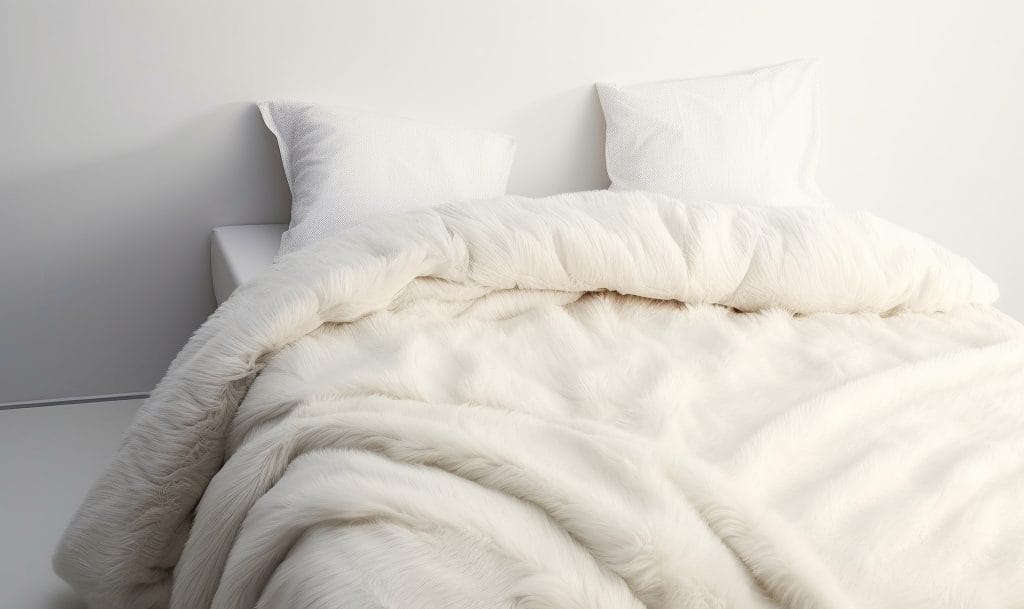What Does Polyester Comforter Feel Like? Exploring Texture
Wondering what a polyester comforter feels like?
It feels smooth and silky, providing a lightweight and cool embrace, perfect for summer nights.
Polyester’s durability and stain-resistant nature make it a practical, low-maintenance choice.
The comfort level can be influenced by the thread count, with higher counts offering a softer, more luxurious feel.

Key Takeaways
- Polyester comforters have a smooth and silky texture, providing a soft and comfortable surface.
- They offer warmth and insulation without feeling heavy or bulky, thanks to their lightweight nature.
- Polyester comforters have excellent breathability and air circulation, enhancing airflow for coolness and comfort.
- They are lightweight and fluffy, contributing to a cozy and inviting sleeping experience.
Softness and Texture
Polyester comforters have a smooth and silky texture that provides a lightweight and cool feel against your skin. The polyester blend creates a soft and comfortable surface, making it an ideal choice for those seeking a cozy bedding experience.
While thread count is an essential consideration, the unique properties of polyester contribute to its overall softness and texture. The fabric’s ability to resist wrinkles and maintain its shape adds to its appeal, ensuring a consistently smooth and inviting feel.
This makes polyester comforters an excellent option for those looking for a low-maintenance yet luxurious bedding choice. Whether used on its own or as part of a layered bedding ensemble, the softness and texture of polyester comforters offer a delightful experience for your comfort and satisfaction.
Warmth and Insulation
Experience the warmth and insulation of a polyester comforter as it envelops you in a cocoon of comfort throughout the night. Polyester comforters are designed to provide insulation, keeping you warm in cooler temperatures without feeling heavy or bulky.
The lightweight nature of polyester makes it an ideal choice for those seeking warmth without the extra weight. Additionally, polyester comforters are versatile enough to be used year-round, providing comfort in both hot and cold weather. If you desire a cooler option for hot weather, consider a cotton quilt, but for a balance of warmth and breathability, a polyester comforter is an excellent choice.
Its ability to provide insulation while remaining cool and lightweight makes it a practical and comfortable option for various climates and seasons.
Breathability and Air Circulation
You’ll often find that polyester comforters allow for excellent breathability and air circulation, keeping you comfortable in various climates. The fabric’s ability to not easily absorb water and its quick-drying nature contribute to its breathability, ensuring that air circulates freely. This keeps you cool and prevents discomfort, particularly in warmer seasons.
Additionally, the impact of thread count on the comfort level of polyester comforters can influence their breathability, further enhancing the airflow. Polyester’s stain-resistant properties also help maintain its breathability and air circulation over time, ensuring that you can continue to enjoy a comfortable sleeping experience.
As we move on to discuss the weight and fluffiness of polyester comforters, you’ll discover how these factors contribute to their overall feel and performance.
Weight and Fluffiness
A polyester comforter feels both lightweight and fluffy, providing a comfortable sleeping experience without adding unnecessary bulk. When considering the weight and fluffiness of a polyester comforter, it’s important to take into account the following factors:
- Thread Count: A higher number of threads per square inch can result in a more tightly woven fabric, potentially impacting the overall fluffiness and weight of the comforter.
- Seasonal Considerations: While the lightweight nature of polyester is beneficial in warmer seasons, the fluffiness can provide added comfort. However, a tightly woven fabric might make it feel hot in summer.
- Balanced Feel: The combination of lightweight and fluffiness in polyester comforters offers a balanced feel, suitable for a variety of preferences.
- Cozy Comfort: Despite its lightweight nature, the fluffiness of polyester comforters contributes to a cozy and inviting sleeping experience, making them an excellent choice for bedding.
Overall Comfort Level
When it comes to the overall comfort level of a polyester comforter, you may find that the combination of lightweight and fluffiness creates a balanced and cozy sleeping experience. The polyester material offers a soft and smooth feel, contributing to a comfortable night’s rest.
Additionally, the quick-drying properties of polyester help to regulate body temperature, preventing discomfort caused by excessive sweating. The overall comfort level is further enhanced by the stain-resistant nature of polyester, providing peace of mind, especially for those with young children or pets.
Furthermore, the low-maintenance aspect of polyester comforters allows for easy cleaning, as they can be machine-washed in hot water, ensuring a fresh and comfortable sleeping environment.
Frequently Asked Questions
Is a Polyester Comforter Comfortable?
Yes, a polyester comforter is comfortable. It offers a lightweight and cool sleeping experience, with quick-drying and stain-resistant properties. The sleek and smooth feel, along with durability, makes it a practical and inviting bedding choice.
What Does Polyester Bedding Feel Like?
Polyester bedding feels soft, lightweight, and breathable, making it a practical choice for summer. It has a sleek look and is quick-drying due to its water-resistant properties. The fabric is durable and stain-resistant, requiring low maintenance.
Does Polyester Comforter Make You Sweat?
Yes, a polyester comforter can make you sweat, especially if you’re prone to sweating at night. Polyester’s low water absorption and quick-drying properties can lead to a cooler, less-sweaty sleep experience.
What Material Is the Most Comfortable Comforter?
The most comfortable comforter material depends on personal preferences. Natural materials like cotton offer softness and breathability, while synthetic options like polyester provide lightweight warmth. Consider thread count for breathability or durability. Choose based on your comfort needs.
Conclusion
In conclusion, a polyester comforter feels smooth, silky, and lightweight, providing a cool and comfortable sleeping experience, especially during the summer months.
Its durability and stain-resistant properties make it a practical choice for low-maintenance bedding.
The overall comfort level can be influenced by the thread count, with higher thread counts offering a softer and more luxurious feel.
